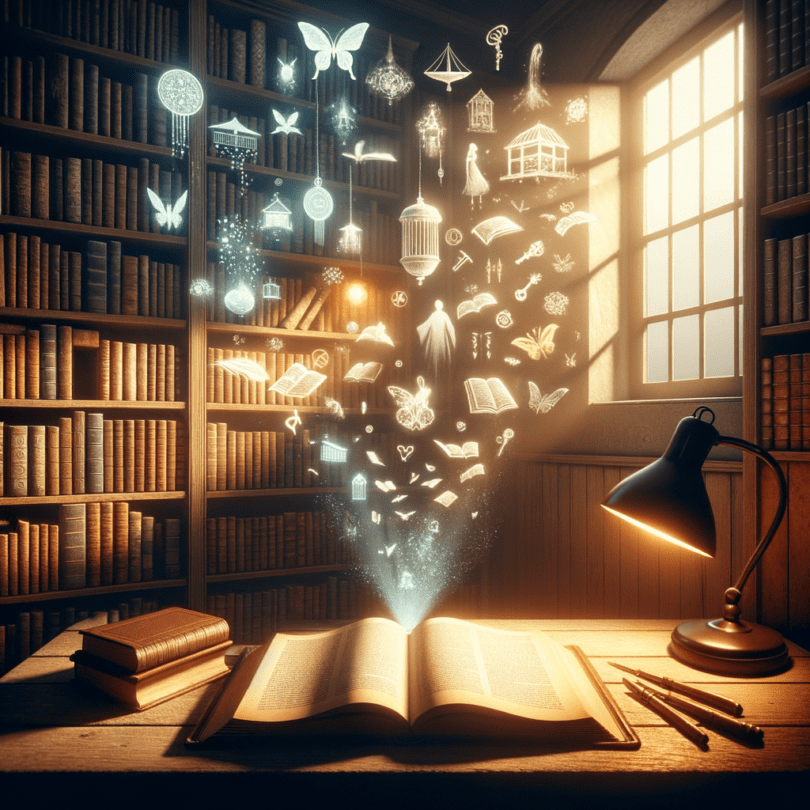Metaphors. Gosh, they’ve always had a special little corner in my heart. There’s something so utterly charming about them—like finding a dusty old key that let’s you peek into a hidden world right here in our own. Every time I find myself knee-deep in a book that’s sprinkled with them, it’s like I’m on this wild treasure hunt, one I didn’t even know I was on, discovering unexpected gems page by page.
Metaphors: A Bridge to Understanding
In my mind, metaphors have always been a bridge. But not one you drive over or anything—that’d be too stuffy, right? Nope, this bridge isn’t made of steel or wood; it’s this magical passageway connecting our everyday, sometimes bland world to one rich with imagination and fresh insights. Take “time is a thief,” for instance. You instantly picture time in a sneaky black cape, pinching our precious moments before we know it. It’s wonderfully vivid, isn’t it?
Now, when it comes to literature—boy, do metaphors shine bright. I remember being just captivated by “To Kill a Mockingbird.” The metaphor of a mockingbird isn’t just about a bird in there. It’s about innocence, it’s about Tom Robinson and every soul facing injustice. Through those metaphors, readers like us get nudged into seeing deeper, questioning more, and, importantly, feeling the characters’ struggles as our own.
The Emotional Power of Metaphors
Ah, emotions. They’re like that double-edged sword, aren’t they? Beautiful and confounding all at once. Metaphors have this weirdly magical way of diving right into our emotional reservoirs. When someone says their heartache feels like “an anchor pulling them to the seabed,” you get it. You don’t just hear it; you feel that drag, the weight of it all.
I remember trudging through a rough time and stumbled upon this poem that used a storm as a metaphor for inner chaos. And man, did it hit home. Those raging winds, the unrelenting rain—it mirrored exactly how I felt, like I wasn’t lost in my mess all by myself.
Metaphors don’t just explain; they take you by the hand, letting you walk those chewy emotional miles in someone else’s shoes. It’s like reading raw empathy on a page.
Metaphors Across Cultures
Isn’t it cool how metaphors waltz across cultures, though? They’ve got this knack for feeling relatable no matter where they’re from yet stay distinctly themselves. Like, a metaphor about mountains means one thing in Nepal and probably something else in Switzerland. And then there’s the Japanese “mono no aware,” a metaphor that captures the tender sadness of life’s fleeting beauty.
There’s something utterly delightful about how different cultures lend fresh meaning to universal metaphors, making stories all the richer. Translators, oh my, have their work cut out for them. It’s like they engage in a sort of alchemy, preserving metaphors’ spirit when swapping languages. Hats off to them—it’s a real art.
Metaphors as A Tool for Creativity
What tickles me most about metaphors? Their crazy ability to fire up creativity. Crafting a good metaphor is like opening new doors in a storyline, each more intriguing than the last. They let writers push boundaries, telling tales in ways we didn’t know we craved. Like how J.K. Rowling wove them into a world teeming with magic, exploring friendship, bravery, and the whole human gamut.
As readers, we’re just as busy keeping up, piecing together metaphors like a jigsaw puzzle. When it clicks, it’s pure euphoria. And what’s fun is that metaphors are open-ended puzzles. My take might be miles apart from yours, sparking all sorts of juicy conversations and insights.
Challenges of Metaphorical Writing
But hey, not every sail is smooth, right? Metaphors can misfire too. They can be awkward or try too hard, sticking out like a sore thumb (ironically another metaphor!). Crafting them is a balancing act—lay them on too thick and it becomes a parody; too thin and it loses punch. And sometimes, what feels profound to one might just be puzzling to another.
I’ve had my share of metaphor mishaps. Trying too hard to shove them in where they didn’t belong, only to end up bursting the story’s bubble. The trick is to remain genuine, letting them bubble up naturally, rather than overshadow the tale.
Conclusion: Metaphors as Life’s Colors
As you’ve probably guessed, I just adore metaphors. They sprinkle colors onto the stark black-and-white photographs of life. They turn silent movies into symphonic masterpieces. They shape our understanding, making the mundane incredibly vivid.
Through metaphors, writers extend an invitation—not just to wander through pages, but to explore their world. They subtly mold perceptions, urging us to seek the spaces between words. Next time you get lost in a story or poem, watch out for those bridges. Who knows where they might lead you?
Maybe, just maybe, you’ll stumble upon a metaphor capturing your life’s essence—a literary reflection showing you a fresh view of yourself. And that, my dear fellow traveler, is the enduring magic of metaphors.

